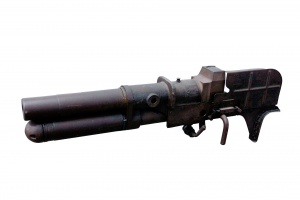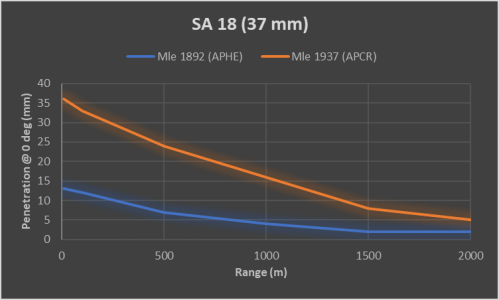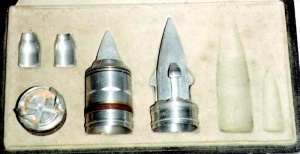Difference between revisions of "SA18 L/21 (37 mm)"
(add info on historical rounds (in spoiler to not mistake it from the in-game rounds)) (Tag: Visual edit) |
(corrected the spoiler name) (Tag: Visual edit) |
||
| Line 107: | Line 107: | ||
Despite being completely obsolete by the outbreak of World War II, the SA18 and its infantry counterpart, the SA16, were still widely in service and saw combat with several armies, such as France, Belgium, Poland, Yugoslavia and Finland. | Despite being completely obsolete by the outbreak of World War II, the SA18 and its infantry counterpart, the SA16, were still widely in service and saw combat with several armies, such as France, Belgium, Poland, Yugoslavia and Finland. | ||
| − | {{sp-begin| | + | {{sp-begin|Historical rounds details}} |
While In-game only a limited number of ammunition was made available for this armament, the SA18 was having a pretty wide range of ammunition available. sadly most of them are simply too weak to make it to the game while other could really make the gun back to a competitive standard. | While In-game only a limited number of ammunition was made available for this armament, the SA18 was having a pretty wide range of ammunition available. sadly most of them are simply too weak to make it to the game while other could really make the gun back to a competitive standard. | ||
Revision as of 15:45, 26 July 2022
Contents
Description
The Puteaux SA 18 (or 37 mm SA 18 L/21 Puteaux) is a gun that first saw use in the First World War, but also the Second World War. It was primarily mounted armoured vehicles and its main use was to suppress the enemy machine gun nests, pillboxes but also infantry. It was a simple and reliable weapon for its role, with a high rate of fire, low chance of jamming and it required only a single person to use effectively. There was a sight mounted to the left of the weapon, which allowed consistent and accurate suppressing fire. Although its penetration power wasn't something to brag about, it was just enough to penetrate most armoured cars of that time.
Adapted from the SA16 infantry support gun, it first appeared as the main armament of the revolutionary Renault FT series. Unfortunately, by the outbreak of World War II its penetration power had fallen well behind armour development.
Vehicles equipped with this weapon
General info
The Puteaux SA 18, or Semi-Automatique 1918 Puteux, was a obsolete gun by the time of WW2. the guns used on the modern french tank was usually scavenged from existing tanks from WW1. which led to a performance normally unfit for the tank battle. the original WW1 rounds offering only a velocity of less than 400m/sec was replaced by higher velocity rounds with a Velocity of 600 m/sec from 1935 onward. this allow the French gun to catch up with the modern gun but not yet enough. weighting 110 kg with shielding, the barrel was a calibres 21. having a fire-rate of 20 rounds per minutes, the gun have a pretty good reload speed but the maximum effectiveness of his penetration is about 400m.
Available ammunition
| Penetration statistics | |||||||
|---|---|---|---|---|---|---|---|
| Ammunition | Type of warhead |
Penetration @ 0° Angle of Attack (mm) | |||||
| 10 m | 100 m | 500 m | 1,000 m | 1,500 m | 2,000 m | ||
| Mle1937 | APCR | 36 | 33 | 24 | 16 | 8 | 5 |
| Mle1892 | APHE | 13 | 12 | 7 | 4 | 2 | 2 |
| Shell details | |||||||||
|---|---|---|---|---|---|---|---|---|---|
| Ammunition | Type of warhead |
Velocity (m/s) |
Projectile Mass (kg) |
Fuse delay (m) |
Fuse sensitivity (mm) |
Explosive Mass (TNT equivalent) (g) |
Ricochet | ||
| 0% | 50% | 100% | |||||||
| Mle1937 | APCR | 600 | 0.5 | N/A | N/A | N/A | 66° | 70° | 72° |
| Mle1892 | APHE | 388 | 0.5 | 1.2 | 6.0 | 15 | 47° | 60° | 65° |
Comparison with analogues
| Comparable cannons to the SA 18 L/21 | |||||
|---|---|---|---|---|---|
| Nation | Name | Year of Production | RPM | Ammunition | Maximum Penetration |
| GER | PaK L/45 (37 mm) | 1934 | 15 RPM | PzGr | 47 mm |
Usage in battles
The SA18 L/21 is, unfortunately, a gun in the wrong world war. Originally intended as a short-range support gun for easy transportation, it was designed as a basic, short-barrelled gun. While this meant it excelled in the role that it was intended for on the battlefields of the First World War, it also meant it quickly became obsolete in view of tank development on the eve of the Second World War. When used in combat against early World War II armour, it is only effective at very short range. If confronted with anything further than 100 yards with more than 30 mm or armour - hold fire if you don't want to attract the enemy's attention.
Pros and cons
Pros:
- Very high firing rate
- Relatively accurate gun
Cons:
- Lack of penetration power (and that is an understatement)
- Light APCR round, doesn't do much damage upon penetration
- Low muzzle velocity, shell drops off very quickly, severely limiting its effective range
History
The 37 mm Puteaux SA18 cannon started life as a development of the Canon de 37 mm à tir rapide Modèle 1916 (SA16), a small but powerful, portable infantry support gun designed by Eugène François Gilbert Garnier (1874-1964) on the instigation of the generals Jean Estienne and Ferdinand Foch. The original purpose of the SA16 was a light gun capable of demolishing pillboxes and gunner nests, with a high rate of fire. Due to its intended use, its range was not considered a priority as part of the gun's design: the result was a relatively small and light weapon, with very high accuracy. When operated by an experienced crew, the gun could fire up to 15 shots per minute, although it had a practical firing rate of 10 shots per minute under normal circumstances. Despite its relatively small size, the original infantry gun would be operated by a crew of 8, consisting of commander, aimer, gunner, four ammunition handlers and one armourer.
With the advent of the first tanks, a variant of the SA16 was developed which could be operated by a single crew member. This gun, the SA18, was technically similar to the SA16 and capable of firing the same ammunition. Crucially though, the gun was never intended as an anti-tank weapon: its primary goal remained that of infantry support gun tasked with destroying enemy machine gun emplacements, the only thing conceptually changing was the addition of a self-propelling function (i.e. the Renault FT-17 tank built around it, allowing it to autonomously move on the battlefield rather than being fired from a static position).
The end of the First World War more or less brought tank development to a halt in Europe. In the absence of any concrete threat and with French tank doctrine firmly based on experience during the First World War, the SA18 was seen as sufficient for the task of providing supporting fire for infantry against enemy troops and fixed gun emplacements. Added to this, the reconstruction of France after the destruction of the First World War and the worldwide economic crisis which erupted at the end of the 1920s, combined with a general anti-war sentiment reigning in politics meant there were little in the way of funds available for the development and replacement of the SA18. Even with a new generation of tanks which were developed at the beginning of the 1930s, these were armed by simply removing the SA18s from the Renault FTs they were supposed to replace and then installing them on the new tanks. As a result, this new generation of tanks, the Hotchkiss H.35, Forges & Chantiers de la Méditerrannée FCM.36 and the Renault R.35 entered production with the outdated gun, even though attempts were made to improve its capabilities by the development of new types of shells. The Obus de rupture Modèle 1935 APCR round offered a higher muzzle velocity than previous ammunition used on the gun, but as it was relatively light it could only do little damage even when if it by chance happened to penetrate.
By this time, the SA18 was seen as an interim solution: the FCM.36, for instance, had been designed with the SA38 in mind, and it received the SA18 with the intention of having it replaced at later date with the SA38. However, owing to a weak turret ring and other structural problems, this refit never came to be, and the FCM.36 entered battle in May of 1940 with a gun that was virtually incapable of penetrating any of the enemy armour it would oppose.
Despite being completely obsolete by the outbreak of World War II, the SA18 and its infantry counterpart, the SA16, were still widely in service and saw combat with several armies, such as France, Belgium, Poland, Yugoslavia and Finland.
While In-game only a limited number of ammunition was made available for this armament, the SA18 was having a pretty wide range of ammunition available. sadly most of them are simply too weak to make it to the game while other could really make the gun back to a competitive standard.
those performance are estimation based on the information available and might not be 100% accurate
| Penetration statistics | |||||||
|---|---|---|---|---|---|---|---|
| Ammunition | Type of
warhead |
Penetration @ 0° Angle of Attack (mm) | |||||
| 10 m | 100 m | 500 m | 1,000 m | 1,500 m | 2,000 m | ||
| Mle 1888 | APHE | 12 | 10 | 6 | 4 | 2 | 1 |
| Mle 1916 | AP | 16 | 14 | 9 | 7 | 5 | 2 |
| 1892 m.24 | APHE | 16 | 14 | 8 | 6 | 4 | 2 |
| Mle1935 | APCR | 27 | 24 | 15 | 10 | 8 | 6 |
| Mle1937 | APCR | 36 | 28 | 18 | 12 | 9 | 8 |
| Brandt 37/25 | APDS | 54 | 51 | 45 | 38 | 30 | 23 |
| Mle 1916 | HE | 2 | 2 | 2 | 2 | 2 | 2 |
| Mle1937 | HE | 3 | 3 | 3 | 3 | 3 | 3 |
| Shell details | |||||||||
|---|---|---|---|---|---|---|---|---|---|
| Ammunition | Type of
warhead |
Velocity
(m/s) |
Projectile
Mass (kg) |
Fuse delay
(m) |
Fuse sensitivity
(mm) |
Explosive Mass
(TNT equivalent) (g) |
Ricochet | ||
| 0% | 50% | 100% | |||||||
| Mle 1888 | APHE | 401 | 0.455 | 0.5 | 0.1 | 22 | 47° | 60° | 66° |
| Mle 1916 | AP | 410 | 0.45 | N/A | N/A | N/A | 47° | 60° | 65° |
| Mle 1892 m.24 | APHE | 388 | 0.555 | 0.5 | 0.1 | 15 | 47° | 60° | 65° |
| Mle 1935 | APCR | 600 | 0.39 | N/A | N/A | N/A | 66° | 70° | 72° |
| Mle 1937 | APCR | 600 | 0.5 | N/A | N/A | N/A | 66° | 70° | 72° |
| Brandt 37/25 | APDS | 825 | 0.30 | N/A | N/A | N/A | 75° | 78° | 80° |
| Mle 1888 | HE | 440 | 0.367 | 0.01 | 0.1 | 30 | 79° | 80° | 81° |
| Mle 1937 | HE | 440 | 0.555 | 0.01 | 0.1 | 56 | 79° | 80° | 81° |
Obus en fonte Mle 1888 (APHE)
this was a training round who had a blunt tip.
Weight : 455 g
Velocity : 401 m/sec
explosive filler : 22 g
Obus de rupture Mle 1892 m.24 (APHE)
this rounds was the most used rounds for the SA18. initially design for usage in WW2, this rounds was meant to provide some support against rather hard target such as the house, pillbox and trench. but not really made for armoured vehicles as it was designed in a time where there was no armoured vehicles. it was made of steel with a bit of explosive filler made of black powder.
Weight : 555 g
Velocity : 388 m/sec
explosive filler : 15 g
Obus ogival plein Mle 1916
initially used for instruction, it was used in WW2 for anti-tank purpose. this round was a simple round made of steel. it could not really be effective against a proper tank, but an armoured car, it would be capable to destroy it.
Weight : 450 g
Velocity : 401 m/sec
Obus de rupture Mle 1935 (APCR)
improved rounds design for anti-tank use. it was solid rounds made of magnesium and hardened steel (possibly having 3% of tungsten). this rounds was producing a white flash at the impact with possible incendiary effect.
Weight : 390 g
Velocity : 600 m/sec
Obus de rupture Mle 1937 (APCR)
more compact rounds used based on the mle 1935. with a magnesium cloak and hardened steel core. this rounds was producing a white flash at the impact with possible incendiary effect.
Weight : 500 g
Velocity : 600 m/sec
Obus Brandt 37/25 (experimental APDS)
experimental sub-caliber round tested in late 1939/1940 to improve the 37mm gun, this rounds was said to be capable to provide a performance similar tot eh 25mm SA34 anti-tank gun. it was made with a 25mm projectile with a possible 20mm tungsten core. there seem to had been an order of 200,000 of those rounds for the infantry but there is no details about this order was delivered or not. this rounds in particular could offer the SA18 a real improvement in firepower.
there is not much details about this rounds weight,the weight can be estimate between 295 and 310 gr.
Weight : 305 g
Velocity : 825 m/sec
Obus explosif Mle 1916 (HE)
standard ww1 explosive round used for support and clearing the trench.
Weight : 367 g
Velocity : 440 m/sec
explosive filler : 30 g
Obus explosif Mle 1937 (HE)
improved explosive rounds who carry more explosive than the previous one making it a rather good support round.
Weight : 555 g
Velocity : 440 m/sec
explosive filler : 56 g
Media
Excellent additions to the article would be video guides, screenshots from the game, and photos.
See also
- PaK L/45 (37 mm) - 37 mm German cannon, used by the Sd.Kfz.251/10
External links
- [Wikipedia] Puteaux SA 18
- French manual of 37mm rounds
- French Manual of the 37mm TR 16 from WW2
- Conversation of the investigation on the battle of france (chief engineer talk about experimental rounds)
- France 1940, L'armement terreste, by stéphane Ferrard, page 93-94
| France tank cannons | |
|---|---|
| 20 mm | 20F2 |
| 25 mm | SA35 L/72 |
| 37 mm | SA18 L/21 · SA38 L/33 |
| 47 mm | SA34 L/30 · SA35 L/32 · SA37 |
| 75 mm | APX · APX Canon de 75 mm modèle 1897 · SA35 L/17 · SA44 · SA49 · SA50 L/57 |
| 90 mm | D.911 APX · CN90 F2 · CN90 F3 · CN90 F4 · D915 · DEFA F1 · SA45 · SA47 |
| 100 mm | SA47 L/58 |
| 105 mm | CN-105-F1 · Giat 105 G2 · Modele F2 · PzK M57 |
| 120 mm | GIAT CN120-25 G1 · GIAT CN120-26 F1 · SA46 |
| 142 mm | ACRA |
| 155 mm | GCT F1 · Schneider 155 C · L'Obusier de 155 Modèle 1950 |
| Foreign: | |
| 15 mm | MG 151 (Germany) |
| 20 mm | MG 151 (Germany) |
| 30 mm | Bushmaster 2 Mk.44 (USA) |
| 37 mm | M6 (USA) |
| 40 mm | Bofors L/60 · QF 2-pounder (Britain) |
| 75 mm | KwK42 (Germany) · M3 (USA) · M6 (USA) |
| 76 mm | M7 (USA) |
| 90 mm | M3 (USA) |
| 105 mm | M4 (USA) |






